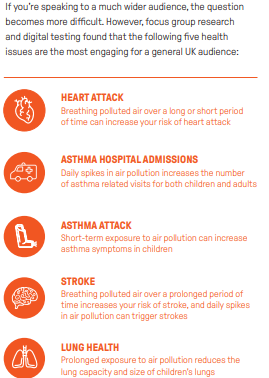
The toolkit offers practical tips on how to best engage the public on the subject of air pollution, highlights the health conditions that most people care about and recommends the most effective language and imagery choices to communicate your message. Whether you are an experienced campaigner, grassroots activist, local parent or concerned health professional, this toolkit is for you.
Key messages
1. Discuss the conditions most relevant to your audience. Based on focus groups research and digital testing, the UK general public care most about; Heart Attacks, being admitted to the hospital for asthma, asthma attacks, strokes and lung health. For a general audience, we recommend you focus on these health impacts. If your audience is concerned with a particular health impact, focus on that one. The key point is to speak to your audience about the health condition that matters the most to them and their loved one.
2. Use easy to understand language. Simple, qualitative statements explainingthe link between air pollution and health conditions such as ‘Daily spikes in air pollution in London can trigger heart attacks.’ are generally the best way to engage the public. Quantitative statements such as ‘The risk of out of hospital cardiac arrest in London is 2.2% higher on high air pollution days than lower air pollution days.’ can also engage new audiences but are generally less effective. On the whole, qualitative statements are more impactful.
3. Make sure the statements are believable. When discussing health conditions it is important to not over-exaggerate the truth. Research suggests that the general public is most engaged by statements that are not overly dramatised. Furthermore, make sure that you are ready to back up any statements shared with the correct data and citations.
4. Be local. Using images of popular and specific sites, relevant to the target audience, is more engaging than using generic images. This holds true across audiences, geographies and issues.
5. Use images that contextualise the issue. On the whole, images that reveal the impact of air pollution on one’s health, such as images of an ambulance (when talking about hospitalisation) or illustration of an affected organ are more engaging than images of people or generally polluted cities.
6. Don’t be afraid to experiment with other messages. The findings in this toolkit are relevant to the broad British public and make use of the latest available research. If you have a particular target in mind, another statement and image might be more relevant to that group. Don’t be afraid to test results continuously, as we learn even more about the harmful effects of air pollution and human health.